
The semi-auto vs bolt-action debate comes down to a numbers game among the cartridge used, system weight and intended end-use.
Why The Bolt-Action Rifle Out Performs Semi-Autos In Precision Work:
- Bolt is locked for the entirety of firing, thus no loss of gas.
- Chambers are generally cut tighter.
- It's a more rigid system, producing less flex when fired.
- Bolt guns' maximum barrel diameter is equal to its receiver.
- Magazines are longer, leaving room for long loads.
Today, we have a skewed perception of exactly what “long range” is. The definition is fluid, but “long range” can be boiled down to two things that are inseparably connected: rifle type and target type. This relationship determines the bullets, cartridges and general support equipment that are used.
Long range for a hunting-class .30-06 on deer is very different than long range for a .338 Lapua on steel plates. With the old aught-six, you must be concerned, not just with hitting the deer, but also hitting it in a vital place … and you’ll want to know what your bullet does when it gets there. With the .338 Lapua, you’re only concerned with simply getting the bullet to contact steel.
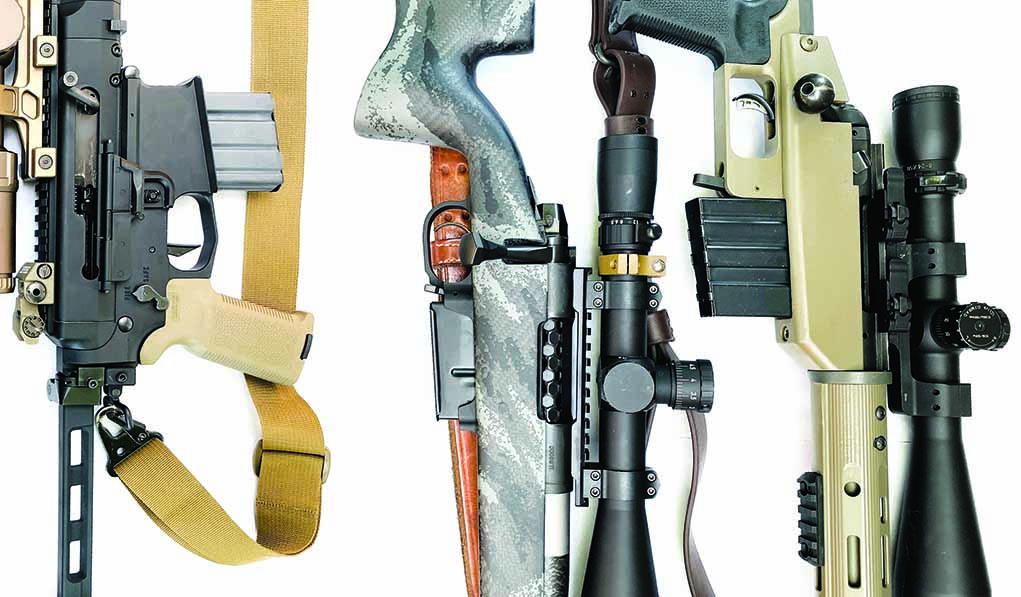
In general, “normal” range for rifles is considered to be about 500 yards. The old-timers consider that to be iron sight distance. Past 500 yards, things change—and, for many, the “midrange” is between 500 and 800 yards. “Long range” for many target shooters starts at about 900 yards (880 yards being a half-mile) and goes to about 1,500 yards (just over ¾ of a mile). Beyond this is “extreme range,” which has no real limit.
Bolt-Actions Vs Semi-Autos
Today’s semi-auto rifles are substantially better than they were, even five years ago, to the point that many long-range shooters and military circles have been moving to them for general use. However, today’s bolt-actions are also better than they were and are not at all being replaced for roles for which maximum precision is needed.
The first, most basic and most important factor in the bolt-action vs semi-auto conversation is the number of moving parts in the system. For this reason alone, bolt guns as a class will always have greater inherent accuracy potential than a semi-auto. The bolt is locked up for the entirety of the firing process, and there’s no real loss of gas due to the barrel being untapped for a gas system. When it comes to ammunition in a bolt-action, there’s no finicking with getting loads to cycle, and chambers can be cut tighter.
On the other hand, a semi-auto can be restrictive and picky. The sheer number of moving parts in a common AR-pattern rifle is astounding, and their reliable operation depends on all sorts of factors, from buffer weight to the gas port size. Just because it’s reliable doesn’t mean it’s accurate (and vice versa). There has to be a happy medium when it comes to reliability and accuracy, and this can be hard to realize.
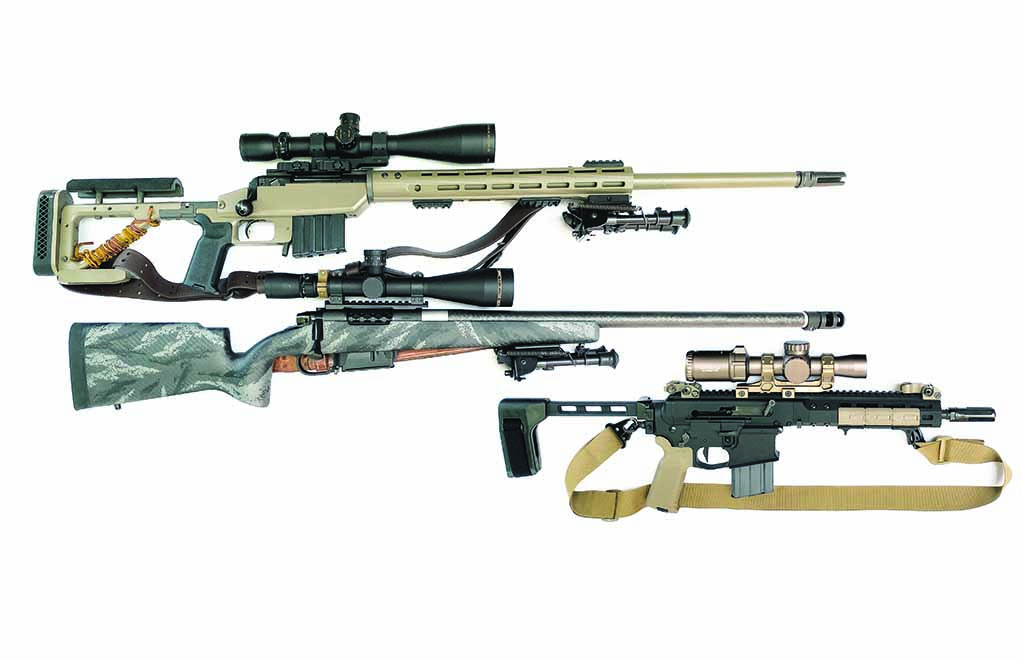
Next, rigidity is a critical component of the variances between bolt guns and semi-autos. A bolt-action, especially with a modern metal chassis, is extremely rigid.
Exactly what is “rigidity,” and where does it fall in this equation? Well, rigidity is simply how stiff the entire rifle is. The more rigid it is, the more repeatable it is. Repeatability is a factor here, in that we don’t want parts moving that shouldn’t be moving. This applies to the firing cycle and the gun’s firing duration. This is important in a match, during which a high round count can introduce heat into the receiver and barrel.
Part of rigidity is bedding. Most bolt guns’ actions are held in place to the stock by screws. In some guns, bedding blocks are used; others are bedded in place with epoxy to make the stock-to-action fit exact. Most modern metal chassis use a V-block system that doesn’t require traditional bedding. Because of how the action fits so tightly with the stock, there’s no play or movement during the firing cycle.
A semi-auto AR struggles with rigidity because of how it’s designed. The upper and lower receivers will virtually always have some play between them due to them being two pieces. When it comes to the upper receiver, the entire assembly needs to be as rigid as possible with as strong a hand guard as possible. Pinning the gas block isn’t recommended for accuracy on a precision rifle.
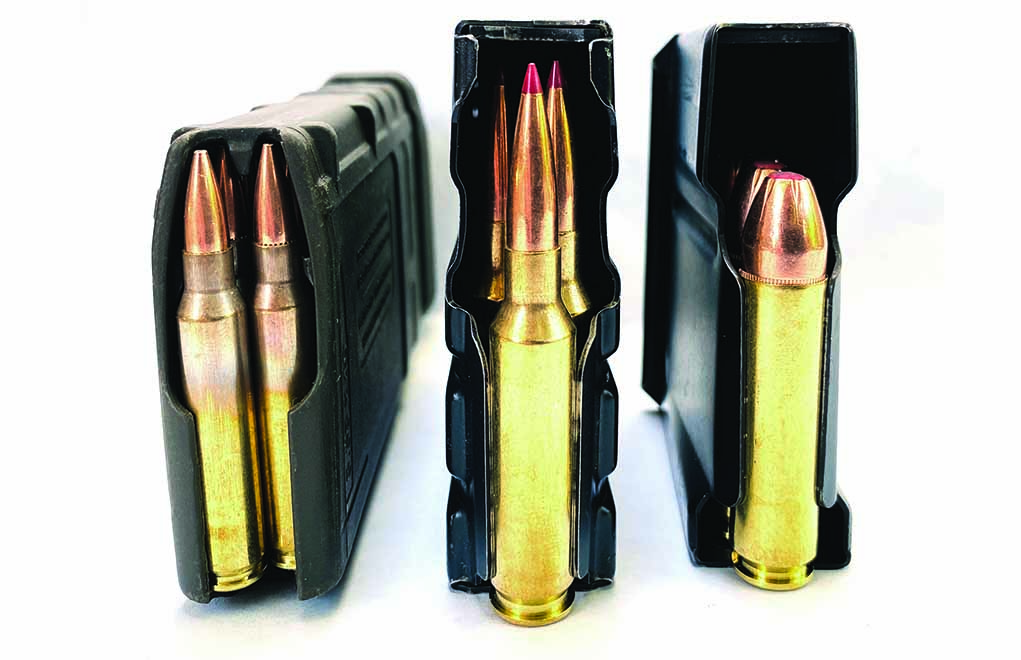
Other limiting factors are the weight and size of the barrel used on an AR. Only diameters capable of fitting into the confines of the upper with gas system in place will work, and most of these are quite thin by comparison to those available on a bolt-action. Most bolt-actions have a maximum barrel diameter that’s the same width as the receiver, itself, thus making heat concerns and system weight very flexible for the end user.
Optics and their means of attachment actually vary very little between these two rifle types. The common monolithic AR scope mount is something of a standard now, because people now understand that scope height is not as critical an element as it was thought to be in the past. This, combined with adjustable cheek rests, has definitely improved how we mount optics today.
The optics in this article comprise a Leupold VX-3i LRP 6.5-20x50mm in a Geissele Super Precision mount and a Sightron SIII SS 6-24x50mm in a Midwest Industries QD mount. They’re easily swapped between/among rifles and are completely repeatable upon re-installation.
Get More Bolt-Action Info:
- 5 Tips To Make Your Bolt-Action Rifle More Accurate
- Bolt-Action Upgrade: Rifle Bedding In 12 Steps
- Bolt-Action Rifles: Push Feed Vs. Controlled Feed
- Top 16 Affordable Precision Rifles — Bolt-Action Edition
- Top 22 Sharp-Shooting 6.5 Creedmoor Rifles
Cartridge Considerations
The long-range game is ever-changing. Technology keeps marching on (but this is a critical point of the discussion). Today, we’re innovating within existing platforms and living by the limits of receivers and magazines—not necessarily inventing new systems to accommodate high-performance cartridges.

The popular 6.5 Creedmoor is a fantastic cartridge. When it first began gaining popularity, I was skeptical of it and saw it as something of a “gateway cartridge” to better long-range rounds. My initial impression was that it would “fall off the wagon,” along with dozens of other fads that have come and gone. But, it didn’t, and it’s now my preferred long-range round, even over new developments that are technically better.
The reason the 6.5 CM became so popular was that it exceeded what the .308 Win. could do in the same size action. The .300 Win. Mag. is easily better than 6.5 CM, but more people own AR-10s and .308-class rifles than they do the big magnums for portability and low recoil. The upgrade was only a barrel change for ballistics that rivaled larger rounds. The 6.5 CM just made too much sense.
Today’s long-range game fits within the constraints of common actions and parts. When it comes to bolt-action vs semi-auto systems, bolt-actions field a far wider variety of long-range cartridges due to their overall simplicity. The magazines typically work with any case of similar size.
The Alpha Mags magazines featured in my custom 6.5 Creedmoor will work with that caliber, as well as .308 Win., .260 Rem., 6mm Creedmoor, .22-250, .338 Federal, .450 Bushmaster … and so on. AR magazines are much pickier and typically have to be specifically designed to feed with a given cartridge. Special magazines are required for .224 Valkyrie, 6.5 Grendel, 6.8 SPC, 7.62x39mm, .450 Bushmaster and .458 Socom.
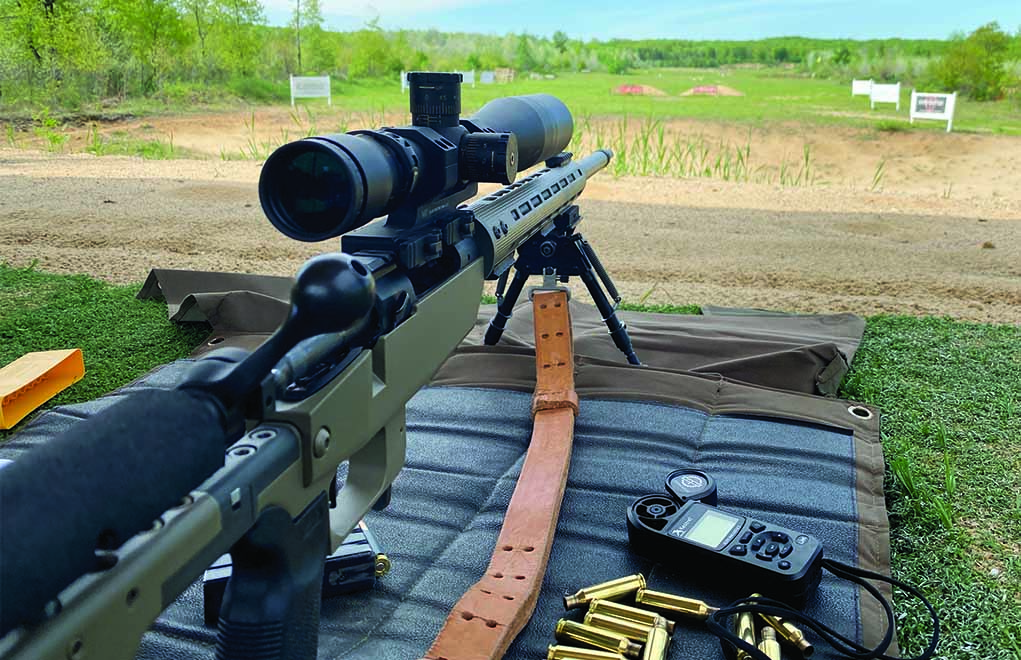
The long-range semi-auto’s most seriously limiting factor consists of the size limitations imposed by the magazine and how those factors correspond to reliable feeding. Most bolt-action magazines have room for long loads, but the same isn’t so in AR-pattern magazines.
Single-shot adapters are common in match shooting with the AR past 500 yards, where the long-for-caliber, 80- to 90-grain bullets need to be fed in, one at a time. Gun sizes of .308 and 5.56mm are standard for semi-autos; anything else is a massive step up in cost and rarity, and the calibers are very limited. There’s little payoff when moving to a semi-auto .338 Lapua or .300 Win. Mag. when a far more accurate bolt-action can be procured for far less money.
The Outer Limits
To test some of the differences in bolt-action vs semi-auto platforms past 1,000 yards, I used a 6.5 CM (which is designed for maximum performance at those distances) and the state-of-the-art semi-auto from Sig Sauer—the SIG716 G2 DMR, also in 6.5 Creedmoor. The Sig rifle is a field-dominating precision rifle and is just about as good as an off-the-shelf semi-auto rifle gets.
I traveled to the world-class Marksmanship Training Center in Lake City, Michigan, to see what these differences looked like.
The MTC range has steel targets spread out over a vast 1,000-plus-yard range at unknown distances, which makes it a great challenge. The hit probability with the 6.5 CM is high in general, if you apply the basics.
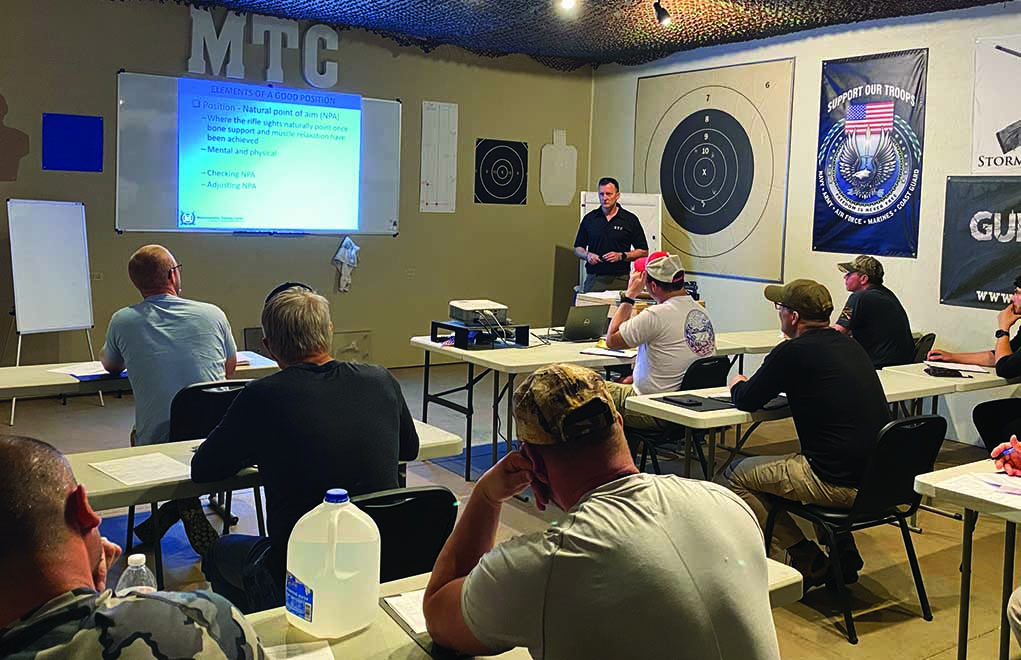
However, where things began to change was surprisingly at the 400-yard line. At those ranges, follow-up shots are slow, so the speed of target acquisition was not that different between the two, because both are low recoil. Hit probability with the bolt-action was 90 percent at ranges to 900 yards on the plates. That last little bit out to 1,050 resulted in a 75 percent hit rate on 18×18-inch plates—mostly due to wind deflection—but once I was on, tight groups resulted.
My bolt-action easily does ½ MOA at 1,000 yards with 143-grain Black Hills Gold in 6.5 CM. To make it fair, this was the primary load tested in both rifles, although Sig Sauer 140-grain match loads were also used, because the 716 came with a test tunnel target displaying accuracy potential with that load.
The 716 DMR was excellent on body-sized targets out to 800 yards, but I could tell it wasn’t keeping up past that. Head targets were hard to hit, even with the help of the Kestrel weather station. The 143-grain bullets left the muzzle a full 200 fps slower than the bolt-action, which was slinging them at 2,800 fps. The lower muzzle velocity, lighter weight and thinner barrel made for a fast package … but at the cost of some precision.
The differences between the two types of rifles are the theory of application. The Sig rifle is state of the art and is designed for multiple roles. It was very capable of hitting past 1,000 yards, but it wasn’t as easily done as with a dedicated—but very heavy and clunky—long-range bolt-action. All things considered, the Sig 716 is a far more useful rifle for most people and is actually more cost effective, as compared to a custom bolt-action. It can, and did, do well at long range, but I was far more comfortable at 400 to 800 yards, and it was much more maneuverable among barricades.
Bolt-Action Vs Semi-Auto: The Decision Is Yours
The argument of bolt-action vs semi-auto rifles comes down to a numbers game among the cartridge used, system weight and intended end use. These factors are then applied against your financial investment.

The Mesa Precision carbon-fiber rifle shown here is just over half the weight of the 716 and a full one-quarter the weight of my heavy target rifle. But, it’s just as accurate as the latter … it’s also twice as expensive! The price of “no compromise” is high, and a rifle such as the Mesa is out of the reach of many shooters who have to decide among weight, accuracy and dependability.
If you plan on maximum precision, a bolt gun is your best bet, in terms of accuracy generated per dollar spent. You’ll never really get the same on-target accuracy using a semi-auto for equal or greater expense. Get the best system for the ranges at which you plan on shooting. If you’re 100 percent inside 800 yards, a semi-auto makes sense for most people. If you get past that to 1,000-plus yards, a bolt-action takes over noticeably and is a substantially better investment.
The article originally appeared in the 2020 Long-Range issue of Gun Digest the Magazine.

Next Step: Get your FREE Printable Target Pack
Enhance your shooting precision with our 62 MOA Targets, perfect for rifles and handguns. Crafted in collaboration with Storm Tactical for accuracy and versatility.
Subscribe to the Gun Digest email newsletter and get your downloadable target pack sent straight to your inbox. Stay updated with the latest firearms info in the industry.

![Best Concealed Carry Guns In 2025 [Field Tested] Wilson Combat EDC X9S 1](https://gundigest.com/wp-content/uploads/Wilson-Combat-EDC-X9S-1-324x160.jpg)


![Best 9mm Carbine: Affordable PCCs [Tested] Ruger Carbine Shooting](https://gundigest.com/wp-content/uploads/Ruger-Carbine-Shooting-100x70.jpg)
![Best AR-15: Top Options Available Today [Field Tested] Harrington and Richardson PSA XM177E2 feature](https://gundigest.com/wp-content/uploads/Harrington-and-Richardson-PSA-XM177E2-feature-100x70.jpg)

A useful addendum to this article would be to identify any aftermarket devices or tweaks that help to resolve semi-auto (in this case, pretty much AR) deficiencies relative to bolt actions.
If looseness between AR upper and lower is a problem, then what’s available to tighten them? If barrels are thin and the action begins unlocking too soon, then what heavy-barrel/composite barrel and longer-length gas systems are available? Are there barrel makers known for tighter chamber dimensions? After all, if you care about precision, a loose chamber fit for dirty combat conditions is somewhat superfluous for your use.
What cartridges are candidates for hosting the longest, highest BC bullets in the AR platform (i.e. “long loads”), and what twist rates are appropriate for those bullets? My AR, bought in 2016, has a 1:7 twist; what’s the longest bullet in 5.56 that will reliably and accurately stabilize with that twist? Other twists?
Just a few ideas for follow-on articles or supplements to this one. “Turning the AR into a Precision Rifle” would be a very interesting article.
For the bolt rifle, you gave actual statistics (% of hits at X range). But then when you discussed AR pattern semiautomatic without giving the same statistics. This omission makes the article seem biased and unscientific. It would be better to show us multi-shooter data of a significant number of attempts at different ranges with the exact same two rifles. Trust in God. All others? Bring data.
I only trust in cold steel and The Great Unity, Baphomet.